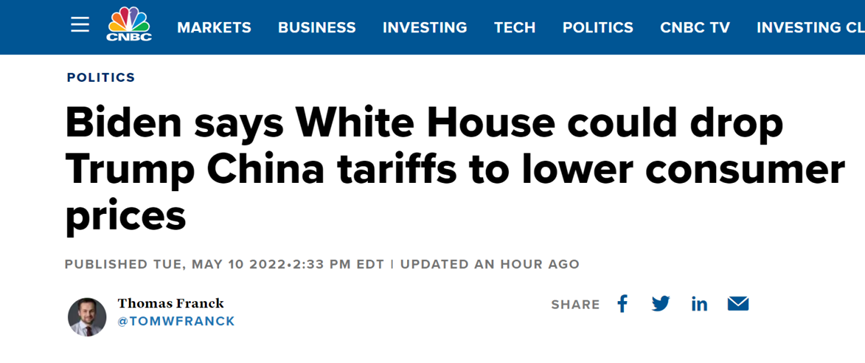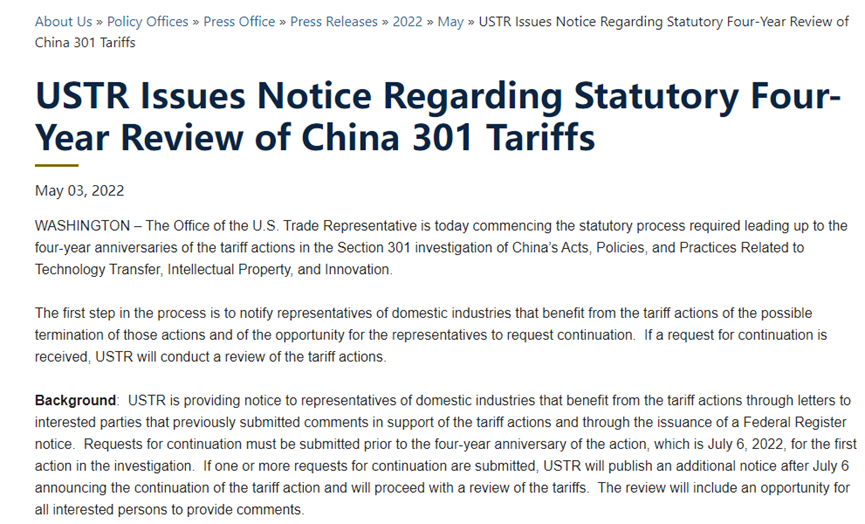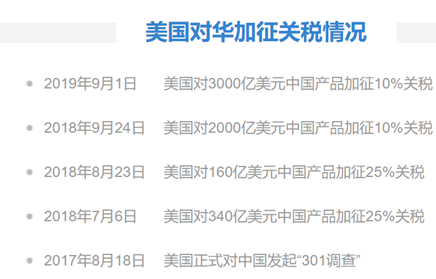The latest news from US CNBC, US President Biden local time 5 On March 10, he said he may roll back some tariffs on Chinese imports to help rein in rising consumer prices in the United States.
According to Biden’s reaffirmation, the dual role of the epidemic and the war in Ukraine And caused U.S. prices to rise at the fastest pace since the early 1980s. “I want every American to know that I take inflation very seriously,” Biden said. “The number one cause of inflation is a once-in-a-century pandemic. It not only shuts down our global economy, it shuts down The supply chain and demand are completely out of control. And this year we have a second reason, which is Putin’s war in Ukraine,” reports that Biden is referring to the war as a direct result of the rise in oil prices.

Before May 3, 2022, the United States The Office of the Trade Representative (USTR) issued a statement stating that the two actions to impose tariffs on Chinese imports to the United States based on the results of the so-called “301 investigation” four years ago will be implemented on July 6 and 8 respectively this year. Due on 23rd. From now on, USTR will start the relevant review procedures. This review process will take a “two-step process”. The first step is that representatives of domestic industries in the United States that benefit from the tariffs imposed on China have the right to apply to USTR to maintain the tariffs before July 5 and August 22, respectively. Tariff, the second step is for USTR to review these applications and accept public comments to make a final administrative decision. USTR will review the relevant tariffs based on the application, and these tariffs will be maintained during the review period.

These two additional tariffs in the review process involve 34 billion respectively U.S. dollars and $16 billion in Chinese goods exports to the U.S.
This follows the USTR announcement on March 23, 2022 The resurgence comes after the announcement to re-exempt tariffs on 352 items imported from China.
What is “301 Investigation”?
The so-called “301 investigation” originated from the US “1974 Trade Section 301 of the Act. In 2018, the Office of the United States Trade Representative (USTR) launched an investigation under Section 301 of the Trade Act of 1974 (Trade Act of 1974) into China’s actions, policies, and practices related to technology transfer and intellectual property rights, and determined that the latter were “Unreasonable, discriminatory, and a heavy burden or restriction on U.S. commerce.” Subsequently, then U.S. President Trump imposed a surcharge of up to 25% on about two-thirds of products imported from China under Section 301. tariff. Some American companies, consumers and other stakeholders expressed concern about the additional tariffs.
Schedule of tariff increase
The chart below lists the reasons for the US to impose tariffs on China schedule. As mentioned above, the two additional tariffs that have entered the review process correspond to the additional tariffs imposed on US$34 billion of Chinese products on July 6, 2018, and the additional tariffs on US$16 billion of Chinese products on August 23, 2018. tariff.

The main isocyanate products, such as TDI and polymeric MDI, are It was included in the list of “September 24, 2018, the United States imposed a 10% tariff on US$200 billion of Chinese products”. From September 24, 2018, the United States will impose a 10% tariff on imports of products such as polymeric MDI and TDI imported from China. On May 6, 2019, the then U.S. President Trump suddenly stated that starting from May 10, 2019, China would impose tariffs on $200 billion of imported goods that were originally subject to 10% tariffs to 25%, and that in the short term A 25% tariff would be imposed on an additional $325 billion in goods.
USTR [Docket Number USTR–2019–0004] The list of US tariffs on Chinese products>
Annex C- [List 3- $200 Billion Action]


U.S. inflation and other factors trigger adjustments to China Commodity Tariff Policy Review
Due to recent conflicts between Russia and Ukraine, continued tension in the supply chain, etc. Factors, the US inflation rate has reached a 40-year high. White House officials in the United States have recently hinted that they will adjust the tariff policy against Chinese goods.
U.S. Trade Representative Dai Qi on May 5, 2022 During his first visit to Canada on the 6th, he told the media that the United States has recently initiated the review process for imposing tariffs on China. make a decision. She said that US-China economic and trade relations have a profound impact on the world. The US should focus on a “durable and effective” strategy to improve its ability to compete with China in the global environment.
The spokesperson of the Ministry of Commerce of China also stated before that,U.S. unilateral tariff increase measures are not good for China, not good for the United States, not good for the world. In the current situation where inflation continues to rise and global economic recovery is facing challenges, it is hoped that the United States will, based on the fundamental interests of consumers and producers in China and the United States, cancel all tariffs imposed on China as soon as possible, and promote the return of bilateral economic and trade relations to the normal track at an early date.
Although it corresponds to polyurethane products such as polymeric MDI and TDI The list of “the United States imposes 10% tariffs on US$200 billion of Chinese products” has not yet expired, and it is not included in the list of the USTR review process. It is the latest policy news on the imposition of tariffs on polyurethane downstream products exported to the United States.



 微信扫一扫打赏
微信扫一扫打赏
